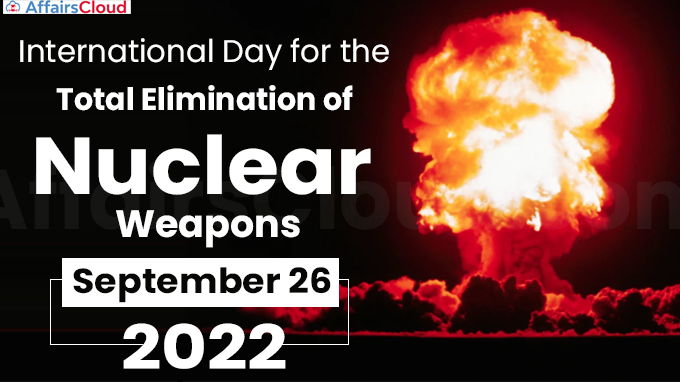 The United Nations (UN)’s International Day for the Total Elimination of Nuclear Weapons is annually observed across the globe on 26 September to raise public awareness regarding the risk created by nuclear weapons.
The United Nations (UN)’s International Day for the Total Elimination of Nuclear Weapons is annually observed across the globe on 26 September to raise public awareness regarding the risk created by nuclear weapons.
- The day highlights the need to eliminate nuclear weapons and the social & economic cost of extending them.
Background:
i. The United Nations General Assembly (UNGA) adopted resolution A/RES/68/32 on 26 September 2013 and declared 26 September as the International Day for the Total Elimination of Nuclear Weapons.
ii. The 1st ever International Day for the Total Elimination of Nuclear Weapons was observed on 26th September 2014.
Nuclear-Weapon-Free Zones:
Nuclear-Weapon-Free Zones (NWFZ), a regional approach, was established to strengthen global nuclear non-proliferation and disarmament norms and consolidate international efforts toward peace and security.
The UNGA resolution (3472 (XXX) B) defines an NWFZ as
- The statute of total absence of nuclear weapons to which the zone shall be subject, including the procedure for the delimitation of the zone.
- An international system of verification and control is established to guarantee compliance with the obligations deriving from that statute.
- The Tenth Review Conference of the Treaty on the Non-Proliferation of Nuclear Weapons (NPT) took place at the United Nations Headquarters from 1 – 26 August 2022.
Treaties Involved in the Nuclear-Weapon-Free Zones:
- Treaty of Tlatelolco- The Prohibition of Nuclear Weapons in Latin America & Caribbean became the 1st nuclear-weapon-free zone, which was opened for signature in 1967.
- Treaty of Rarotonga– The South Pacific became the second nuclear-weapon-free zone in 1985.
- Treaty of Bangkok- The Southeast Asia became third Nuclear-Weapon-Free Zones in 1997.
- START I (Strategic Arms Reduction Treaty) was a bilateral treaty between the United States and the Soviet Union on the reduction and the limitation of strategic offensive arms.
- Treaty of Pelindaba- Africa became the fourth nuclear-weapon-free zone in 1996.
- Treaty on a Nuclear-Weapon-Free Zone in Central Asia- Central Asia became the fifth nuclear-weapon-free zone in 2006.
- On 3 February 2021, the Parties agreed to extend the Treaty between the United States of America and the Russian Federation on Measures for the Further Reduction and Limitation of Strategic Offensive Arms (“new START”) until 4 February 2026.
- Currently, 5 NWFZs, covering most of the Southern Hemisphere and Central Asia. whereas, Antarctica and Mongolia have a special Nuclear-Weapon-Free status.
About the United Nations (UN):
Secretary-General- António Guterres
Headquartered- New York, United States




